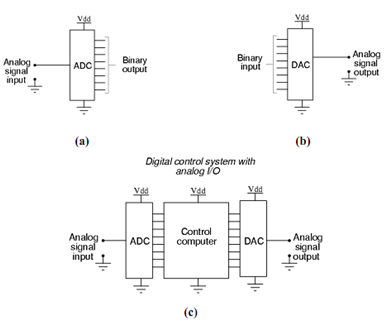Modem:
What does MODEM stands for? The modem is a peripheral device for computers, which permit two computers to communicate over standard phone lines. Modems come in many sizes and shapes to serve all sorts of needs. So how exactly does this common device work? The word modem stands for modulator-demodulator. A modem's main reason is to convert digital information to analog signals (DAC) and to convert analog signals back into useful digital information (ADC) along with modulation and demodulation. Let us study ADC and DAC in brief. Connecting digital circuitry to sensor devices is simple if the sensor devices are inherently digital themselves. Switches, relays, and encoders are simply interfaced with gate circuits due to the on/off nature of their signals. Though, when analog devices are involved, interfacing becomes much more complicated. What is required is a way to electronically translate analog signals into digital (binary) quantities, and vica-versa. An analog-to-digital converter, or ADC, carries out the former task whereas a digital-to-analog converter, or DAC, carries out the latter. An ADC inputs an analog electrical signal such as voltage or current and outputs a binary number. In block diagram form, it may be represented as in Figure (a). A DAC, alternatively, inputs a binary number and outputs an analog voltage or current signal. In block diagram form, it looks like Figure (b). Together, they are frequently used in digital systems to provide complete interface with analog sensors and output devices for control systems such as those used in automotive engine controls as in Figure (c). It is much simplar to convert a digital signal into an analog signal than it is to do the reverse. Hence, we shall begin with DAC circuitry and then move to ADC circuitry.

Figure: Block Diagram of (a) ADC; (b) DAC; and (c) Combined A/D, D/Converters